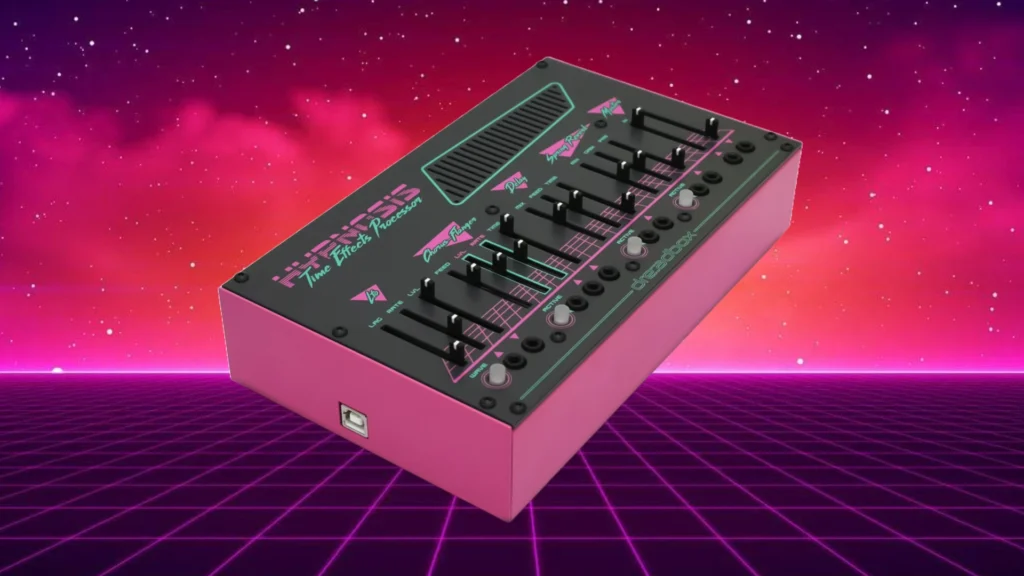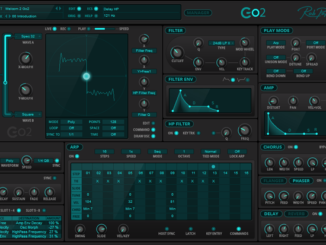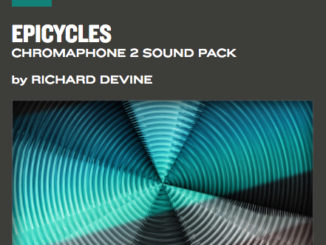Review: Dreadbox Hypnosis Reissue is a super fun hybrid multi-fx box (desktop/Eurorack) that takes your sounds into retro analog lo-fi fields.
In 2018, Dreadbox released Hypnosis, an analog/hybrid multi-fx processor based on the sound charm of the 80s. With this, the Greek developers recognized the trend this early on. Then, in 2020-2021, the farewell. Due to missing components and price increases, Hypnosis was discontinued.
The dev team took advantage of the time and revamped the internal circuit using components currently available in larger quantities. The result is called Hypnosis Reissue.
The Dreadbox team kindly sent me a Hypnosis Reissue (DIY) to review before release.
Dreadbox Hypnosis Reissue Review
The Hypnosis’s first batch (500 units) is only available as a DIY kit. It comprises two PCBs, a front panel, a case, a tank, a USB socket, and accessories. Don’t worry. You don’t have to be a soldering expert. The PCBs are pre-soldered, so all you have to do is attach the spacers and screws.
In the next step, you must marry the two PCBs and attach the spring reverb tank. Once done, the front panel becomes part of the entire project. Depending on whether you use Hypnosis Reissue as a desktop or Eurorack module, the USB module is attached to the back. From here, it goes into the included pink case.
The case is very narrow so the installation can be tricky. With the correct hand movements, it can be put into the case quickly. Our unit is almost finished; the calibration is the final step. This only applies to the analog chorus/flanger, which you can adjust with a Phillips screwdriver on the back.
Sounds difficult? Nope, it isn’t. This and the other construction steps are very well illustrated in the manual, so even those who are not experienced will have no problem with the construction.
Hypnosis vs. Hypnosis Reissue
With Hypnosis Reissue, Dreadbox presents the successor of the original Hypnosis. Both bear the same name but have significantly different features.
The original from 2018 was stereo and had three effects, an LFO, and presets. The reissue is different. This is mono, semi-modular, and has no memory. There are not the same three effects. For example, the multiple delay types are missing: clean, ping-pong, BBD, and tape. But it only cost half what the predecessor cost. In addition, the semi-modularity allows you to use it as a 42HP module in a Eurorack modular Synthesizer.
Hypnosis’ operation has also been revised. There was a shift from using knobs to embracing an all-slider design. As a fan of sliders on Eurorack modules, Dreadbox gets a personal bonus point for this. However, you have to forgo the option to save settings. The reissue here is more immediate and designed for tweaks on the fly. Plus, you can modulate parameters by using the 11 patch points.
Analog Meets Digital
Let’s get to the important ones, the core. This has remained the same apart from a few changes. Hypnosis has an analog signal path with three effects: a chorus/flanger combo, a delay, and a spring reverb. They share analog and hybrid concepts. Plus, there is a built-in, patchable LFO.
Buttons on all three effects can switch them on and off as desired. There is, however, no option to arrange the effects differently. Therefore, the sole choice is to remove effects from the signal chain by deactivating them individually. Good, each button has a dedicated trigger input, allowing you to animate this on/off process. Interesting for creating subtle, rhythmic elements.
Chorus/Flanger
The signal path begins with the chorus/flanger combo. It’s based on analog BBD circuitry and has four controls: feedback, level, rate, and time. Don’t forget to calibrate it before using it. For example, this process removes the noise from the BBD and trims the feedback. This circuit also hosts a wide-range LFO that is hardwired to the effect. There are also two CV inputs for the rate and time and a trigger input for the button.
Don’t expect a very lush chorus like on the Roland Juno synthesizers. You get a rather subtle chorus that makes the sound more organic. To which he spreads character and life. A denser, richer chorus would be nice, but I couldn’t generate it in the test.
The flanger, on the other hand, is more dominant and can be heard more clearly. Be careful with the built-in LFO (1sec-1min). When you crank it up above 90%, it is audible, aka become a VCO. The flanger makes a lot of fun and creates beautiful slower and high-speed flanging effects.
Lovely comb filtering effects are also possible if you work with very high feedback amounts and no modulation on the delay time.
Hybrid Delay
Then, it goes into the delay. This goes through the analog signal path but is digital. So, a hybrid delay (40ms-500ms) with three controls: dry/wet mix, feedback, and time. The time can be controlled via CV, and the ON/OFF button also has a trigger input. Unlike the original Hypnosis, the reissue doesn’t offer multiple types (clean, ping-pong, BBD, and tape) nor the freeze function or modulation on the feedback—a pity.
According to Dreadbox, the delay core comes from the Erebus synthesizer. A delay sound that has shaped the Erebus sound a lot and has a lot of friends.
In practice, I can confirm this. Yes, it’s very Erebus-like. Especially at high values, you get very lush spherical delays. It’s not a super clean delay, but it drifts into the lo-fi fields at high values. The ability to modulate the delay time is a lot and generates some unpredictable patterns. Also, pity is the missing option to sync the delay.
There Is A Tank
Third and final effect is a spring reverb. It’s not a digital emulation but a real one. There is a spring tank on the board. It’s not a big tank with three springs, but it does the job. The spring reverb section offers three parameters: dry wet/mix, gain, and pre-delay time (30ms up to 200ms). This is a little exciting goodie with which you can mangle the sound of it.
It sounds like a classic spring reverb. But you have to be careful how you use it. I wouldn’t recommend 100% mix as it strains the original sound too much. Between 10% and 30%, I got the best results in the test.
The gain setting is also important here. If the sound source does not prevail, you should add some gain. Going higher can lead to distortion. Finding the perfect mix is a delicate job. In addition, the Spring Reverb can quickly oscillate with higher settings or vibrations near the unit. So it becomes an oscillator or even an instrument. The question is: do you want this?
Even though some people see spring reverbs as the holy grail of reverbs, I had difficulty getting the perfect sound here. As I said, it’s a very delicate matter. Nevertheless, you get classic spring reverb sounds. Pay attention to the right input level/gain, and have the perfect mix.
The pre-delay function is a nice extra that lets you get other colors out of the spring reverb, especially with modulation. If you trigger the button, you also get unusual artifacts in the effect. Also nice: The spring tank has two lights: one is for the LFO, and the other shows whether the signal overdrives or not.
LFO & Master
Looking at the left and right ends, you will find further functions. On the left, it offers a multi-wave LFO (triangle, square, random, random gates) with lag, CV-controllable rate, and level controls. This can be freely patched into the respective sockets and has a wide range (1 min – 1ms).
The LFO is more versatile than you might initially think, thanks to different waveforms and lag. Then, you also have a master section where the signals go in and out. Hypnosis Reissue is compatible with Eurorack, line, guitar, and microphone signals. Two sliders allow the levels to be adjusted precisely.
Power
Dreadbox’s new FX box gets power via USB or the built-in Eurorack socket. During the test, I put the module in a different case because my USB plugs produced too much noise. The developers also warn about this in the manual—no problem in Eurorack.
Yes, USB is practical, but I would always prefer a classic power supply, especially on sound processing tools. I linked below an extensive sound demo of the Hypnosis Reissue with examples of synths, Eurorack, and the human voice.
Summary
In summary, the Dreadbox Hypnosis Reissue was convincing in the review. It doesn’t break through walls, okay, maybe if the feedback circuits are at high settings, nor is it an innovative product. But it makes something clever. It bundles three characterful, vintage-inspired effects in a semi-modular, patchable box.
I’m unsure whether we should call it a reissue, as many of the functions of the original are missing. Hades and Erebus were almost identical here with the previous versions. It’s a fabulous FX box for giving your sound analog charm without robbing a bank. Hypnosis not only fits into the retro wave sound fields. It also works great in the experimental sphere. The module/desktop FX effects are fun and grab you immediately. Yes, it’s hypnotic.
It’s a shame that the signal path is only mono. A lot of the charm and flexibility of the original is lost here. Or get two reissues to get it back, hehe. Like the original, there is no tempo sync for the delay, so rhythmic sounds are not the reissue’s specialty. The front panel is again an eye-catcher, and you immediately remember the first Hypnosis. This product is for lovers of crunchy retro, lo-fi sounds without fear of circuit noise.
Pro
- analog/hybrid concept
- price
- front panel design and layout
- pre-soldered and fun DIY project
- build quality
Neutral
- mono-to-mono effect module
- reissue? features original vs reissue
Negative
- USB power issues
- not perfect effects: no tempo sync on the delay, just one delay type, and spring reverb is very sensitive…
Dreadbox Hypnosis is available now for 200€ + VAT + shipping in limited quantities (500 units) as a pre-soldered DIY kit. A pre-assembled version will probably arrive later.
More information here: Dreadbox












I fell in love with the original Hypnosis at Knobcon about 2-3 days before the reissue was announced. After comparing the features and listening to more demos of the original, I had to go for that one instead of the reissue.
In addition to being mono, the reissue doesn’t have the three delay modes (“clean” pingpong, BBD and tape) which are accessed by a button combo on the original. It also lacks the freeze feature, and CV over feedback.
Stereo is pretty important to the character of the chorus/flanger on the original, and the combination of ping-pong delay and a little spring reverb can work very well.
I’m glad I bought the original, but I still think the reissue is a good deal in terms of price/features.
Spring reverb doesn’t work very well for all kinds of sounds, that’s for sure, but IMHO it really adds some magic for other kinds. Also it can be wonderful in feedback loops, and the modulatable predelay on Hypnosis really adds to that.
Danke für das tolle Review!
Hab meinen Bausatz heute bekommen – und – wie beschrieben, gehts tatsächlich sehr leicht von der Hand. Lediglich das Kalibrieren des Chorus / Flanger zaubert mir ein großes Fragezeichen auf die Stirn. Entweder bin ich zu blöd, zu ungeduldig oder einfach nur zu müde … Im Web findet man noch nichts und ich bin für jeden Tipp dankbar!
Beste Grüße, Benji
Geh mal in den Dreadbox Shop, dort findest du die Bauanleitung. Dort wird auch die Kalibrierung des Chorus beschrieben 🙂
Callibration of the Chorus and Feedback is found in the Manual.
But then it says: “Random level is pre-trimmed and should not be
touched. For more info about Random level
please refer to Chapter 11.”
However NO info about “random level” is found in chapter 11.
Would be nice to know what it does – it is hard NOT to touch it 😉